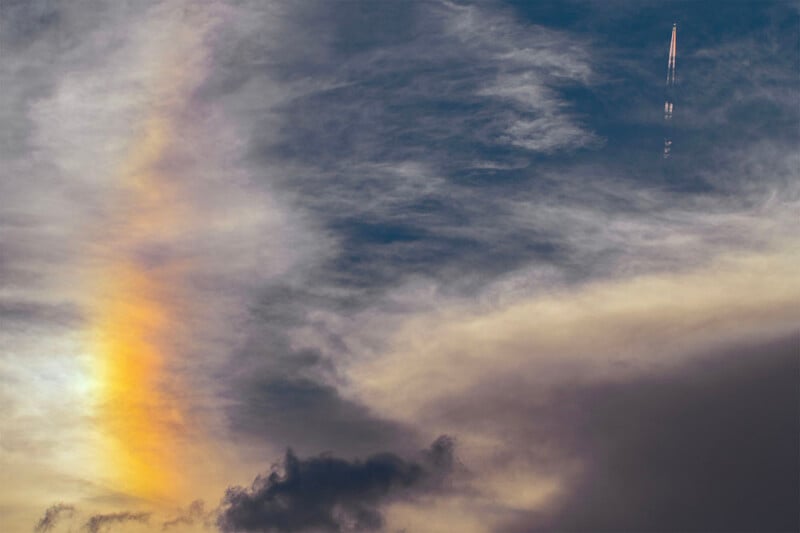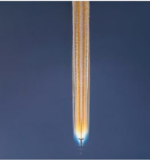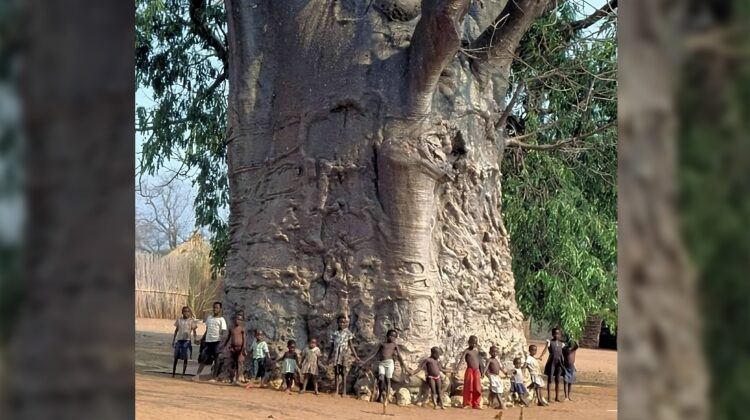Soumyadeep Mukherjee from India, tells PetaPixel that on July 19 he was planning to capture a solar transit of the International Space Station (ISS) but things went awry.
“I had set up by 17:00 on my terrace and was all ready. However, clouds rolled in and I couldn’t capture the ISS,” he explains.
“I was casually roaming on the terrace when I saw sun dogs (another optical phenomenon) and immediately jumped to capture it. While I was capturing it at a somewhat wide angle (150mm), I saw a plane and a contrail towards the right of the image.”
![]()
“I zoomed in at 600mm and I couldn’t believe that I was seeing some colors on that contrail in the live view. I took an image and checked again to confirm,” he continues.
“I took around 20-30 images in the span of 40 seconds. I randomly chose seven images, processed them in Adobe Camera Raw, and finally made the collage in Photoshop.”
![]()
![]()
The resulting photos are colorful vapor trails coming out the back of a commercial jet. But just a few days later on July 24, Mukherjee spotted yet another colorful contrail with his own eyes.
“I immediately took out my equipment and captured the iridescent contrail,” he says “Capturing this rare optical phenomenon has always been on my bucket list and I’m extremely happy to have finally captured it, not once, but twice!”
What are Rainbow Contrails?
The trails in the sky left behind by airplanes are mostly made up of condensed water vapor from airplane engines. Rainbow contrails, or iridescent contrails, are produced by individual water droplets that diffract sunlight.
According to Atmosphere Optics, when the droplets of similar size all diffract their colored light into the same direction the colors become evident to people on the ground.

Mukherjee used his Nikon D5600 with a Sigma 150-600mm attached to capture the images.
In March, PetaPixel reported on how Mukherjee captured Venus and Jupiter over a period of 10 days as they converged toward each other in the night sky.
More of Mukherjee’s work can be found on his Instagram.








 Photographer Finds Locations Of 1960s Postcards To See How They Look Today, And The Difference Is Unbelievable
Photographer Finds Locations Of 1960s Postcards To See How They Look Today, And The Difference Is Unbelievable  Hij zet 3 IKEA kastjes tegen elkaar aan en maakt dit voor zijn vrouw…Wat een gaaf resultaat!!
Hij zet 3 IKEA kastjes tegen elkaar aan en maakt dit voor zijn vrouw…Wat een gaaf resultaat!!  Scientists Discover 512-Year-Old Shark, Which Would Be The Oldest Living Vertebrate On The Planet
Scientists Discover 512-Year-Old Shark, Which Would Be The Oldest Living Vertebrate On The Planet  Hus til salg er kun 22 kvadratmeter – men vent til du ser det indvendigt
Hus til salg er kun 22 kvadratmeter – men vent til du ser det indvendigt  Superknepet – så blir snuskiga ugnsformen som ny igen!
Superknepet – så blir snuskiga ugnsformen som ny igen!  Nearly Frozen Waves Captured On Camera By Nantucket Photographer
Nearly Frozen Waves Captured On Camera By Nantucket Photographer  Meteorite That Recently Fell in Somalia Turns Out to Contain Two Minerals Never Before Seen on Earth
Meteorite That Recently Fell in Somalia Turns Out to Contain Two Minerals Never Before Seen on Earth  It’s Official: Astronomers Have Discovered another Earth
It’s Official: Astronomers Have Discovered another Earth 
o41gv4
a8fhwp
3jy1w1
vt8xoi
rocoy3
565ye9